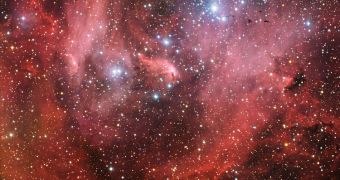A group of astronomers recently managed to snap a new, highly-detailed image of the Lambda Centauri Nebula, which is officially known as IC 2944. Sometimes, experts affectionately refer to it as the Running Chicken Nebula. The new photo reveals the structure's delicate interior.
The data were collected using the Wide Field Imager (WFI) instrument on the MPG/ESO 2.2-meter telescope the European Southern Observatory operates at La Silla, Chile. The remarkable tool is capable of making out very small details in such distant objects.
IC 2944 is located around 6,500 light-years away from Earth, which is relatively close in astronomical terms. When looking at it, many people see the silhouette of a running chicken, hence its nickname.
Some astronomers are puzzled as to which part of the image has the running chicken, since they can make out multiple birds in the MPG/ESO data. But those who nicknamed the nebula thusly say that the chicken's head is located in the center of the image, beak facing down.
The rest of its body, which is oriented vertically, can be seen to the left, spreading towards the upper-left corner of the image. Admittedly, it tends to get a bit fuzzy at times. Throughout the nebula, new stars are forming at a frantic rate, helping to illuminate the fleeing bird.
When viewed through the WFI's special optical filters, the cosmic formation takes on a particular shade of red, which astronomers know to interpret as massive amounts of ultraviolet (UV) radiation exciting molecular hydrogen clouds.
Even more gas can be seen throughout this new image. Scientists believe that IC 2944 is extremely rapid, forming new stars at a frantic pace. The photograph covers an area of the sky roughly equivalent to the surface of the full Moon.
“Aside from the glowing gas, another sign of star formation in IC 2944 is the series of opaque black clumps (called Bok globules) silhouetted against the red background in part of this image,” an ESO press release accompanying the announcement reveals.
“They appear dark as they absorb the light from the luminous background. However, observations of these dark clouds using infrared telescopes, which are able to see through the dust that normally blocks visible light, have revealed that stars are forming within many of them,” the statement adds.

 14 DAY TRIAL //
14 DAY TRIAL //